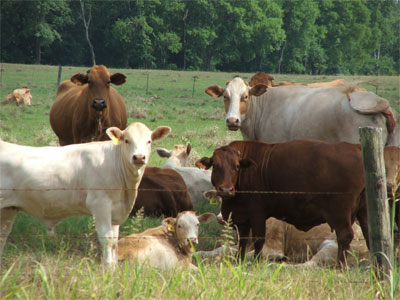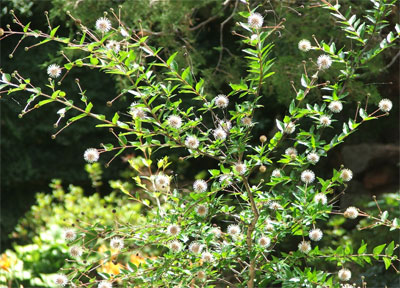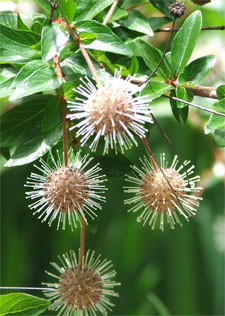Native Son – June, 2010

“No bull,” Steven says of this photo. He goes on to wish fathers a belated Happy Fathers Day. All photos by the author.
Spheres
Two days ago, I was knee-deep in the Chandor Gardens bridge pond, cleaning dead leaves off some of the aquatics and talking religion/philosophy with a guy born in Brazil. We talked of humanity, and how each generation seems to repeat the virtues and transgressions of the generation before … but things appear different due to the ever-changing coat of paint provided by new technology. I can just see Mr. Brodnan, my old high school history teacher, arching that left eyebrow and saying something stoic: “If we do not learn from our history, we are doomed to repeat it.” (See, Mr. B … I did pay attention in class.)
No doubt some things are cyclical, but given the infinite variances involved, I’d like to think the times are actually spherical; a ball can roll a lot more freely than a hoop. I finally came to the conclusion that life is like bowling — the earth is the ball, each revolution is a generation, the lane is the timeline, and there will likely be some kind of smash at the end. And who knows — maybe the universe will set things up straight and the earth will pop up out of the ball return to take another shot at it again.
So I’ve got all of this spherical stuff rolling around my brain, further complicated by my awareness of the summer solstice and all the orbicular oracular that goes with it, when I notice the buttonbush is flowering. Wow … talk about timing!

Buttonbush is a small-leaved native that can reach 15 feet in height.
Buttonbush (Cephalanthus occidentalis) is a small-leaved, large (to 15 feet tall) native Texas shrub that grows near water sources across most of the Lone Star State. Interestingly enough, it is a member of the coffee family, Rubiaceae, a huge, cosmopolitan family that includes garden ornamentals Gardenia and Pentas, Cinchona (source of quinine) and, of course, Coffea, source of the world’s favorite beverage. Noted naturalist Dr. Ken Steigman once introduced me to Hedyotis nigricans, an amazing little wildflower in this family known as prairie bluets. (See, Dr. S … I did pay attention at work.)

Inflorescences (flower clusters) of buttonbush (Cephalanthus occidentalis).
Buttonbush serves my personal life very well. Every year, right about the time the summer swelter starts and I’m asking myself, “Now, why is it I live in Texas and work outside, (!?!)” the buttonbush flowers. Actually, “flowers” is an understatement. Buttonbush produces magical little spheres that make me take them gently in hand and ponder nature’s infinite beauty. The inflorescences (flower clusters) form perfect double spheres; the first composed of perhaps 200 tiny, coffee cream-colored flowers, each tinged with a bit of burgundy, packed petal to petal into a dime-sized ball. Out of the center of each of these tiny flowers arises a pure white, anther-tipped stamen (male part of the flower) that projects out way beyond the petals, creating an overall appearance of a round pincushion with 200 pins inserted in a perfectly symmetrical pattern all over it. Dozens of these double spheres adorn the plant, creating a dazzling display that charms children and amazes adults. I well remember when I was first introduced to this plant (by the famous Texas plantsman Benny Simpson, no less), and how I’ve been enchanted with it ever since.
I take great delight in the fact not only that I planted this particular buttonbush, but that I had to repeatedly protect it from being “weeded out” when it was young, because no one else knew what it was or saw its potential. Everyone seemed to think it was just a scraggly little thing that would never amount to much. But I had faith in that little nub … faith that it would someday come around, create its own mark, and shine brightly, like a star on a moonless night.
Hmmmm … I wonder if this is how all fathers feel.
A belated Happy Fathers Day to my dad, and the rest of the fathers out there.
Peace & love,
Steven
About the author: Steven Chamblee is the chief horticulturist for Chandor Gardens in Weatherford and a regular contributor to Neil Sperry’s GARDENS magazine and e-gardens newsletter. Steven adds these notes:
Come out to Chandor Gardens and see us sometime. Just take I-20 west to exit 409, hang a right, go 2.1 miles and hang a left on Lee Avenue. Head straight 12 blocks and you’re driving in the gates. Call 817-361-1700 to let us know you’re coming, and we’ll light the incense and show you around. You can always go to www.chandorgardens.com for a picture tour and more information.
I can always use another road trip! Let me know if you’d like me to come out and speak to your group sometime. I’m low-maintenance, flexible, and you know I like to go just about anywhere. No city too big; no town to small. Just send me an e-mail at schamblee@weatherfordtx.gov and we’ll work something out.
